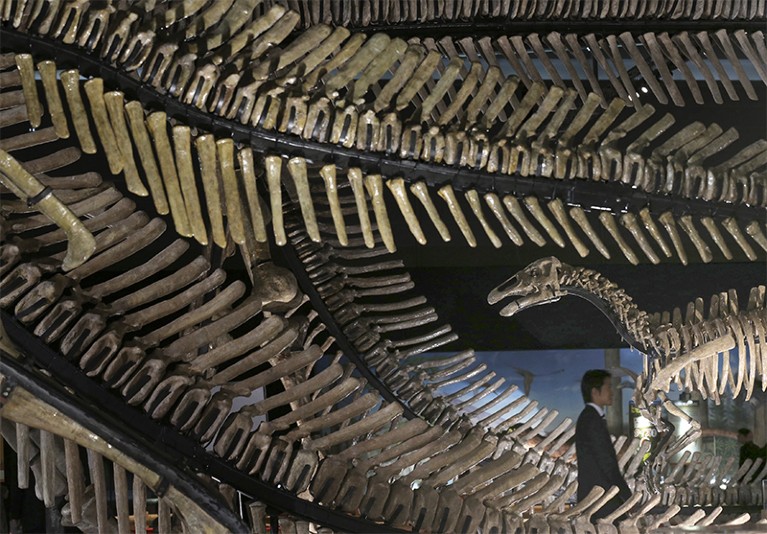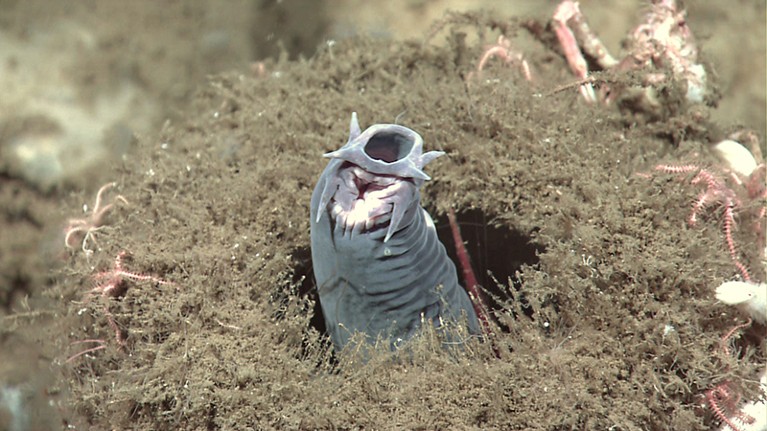
The origin of vertebrates has been an evolutionary mystery for more than a century.Credit: Kim Kyung-Hoon/Reuters
Across the Bridge: Understanding the Origin of the Vertebrates Henry Gee University of Chicago Press (2018)
Some of the great remaining mysteries in zoology concern origins — of multicellularity, complex nervous systems, life cycles and sex, for example. The evolutionary origin of vertebrates is among the most intractable of these, despite more than a century of work spanning a range of disciplines and animal groups.
In Across the Bridge, Henry Gee reviews the most recent research in this area. Gee (the senior editor responsible for palaeontology and evolutionary development at Nature) synthesizes contributions from anatomy, developmental biology, genomics, palaeontology and the study of evolutionary relationships using DNA-sequence data. He also puts forward his own ideas on this fascinating conundrum.
The book is a follow-up to Gee’s 1996 Before the Backbone, which was one of the reasons I decided to pursue research into the origins of chordates (the group including vertebrates, the fishlike lancelets and marine invertebrates called tunicates). At the time, the discipline was intimidating, involving impenetrable papers and a dizzying array of contradictory hypotheses. Gee tamed and synthesized the literature to lay out the history and logic of the most significant hypotheses, such as Walter Garstang’s 1894 auricularian theory. (This posited that the chordate body plan evolved through transformation at the larval, rather than adult, stage.) Before the Backbone inspired novices like me to get excited about the challenges in vertebrate origins.

Hagfish have been neglected in vertebrate studies.Credit: NOAA Okeanos Explorer Program
Is a major new summary of the field warranted, just two decades on? In my view, yes. (Among many others in the field, I encouraged Gee to write this book, and he thanks me for so doing in the preface.) There has been significant progress across disciplines on research into important, yet previously neglected, animal groups at crucial positions in the evolutionary tree. Along with tunicates and lancelets, these include hagfish, lampreys and marine worms called hemichordates. The publication of the genomes of two hemichordates — the acorn worms Saccoglossus kowalevskii and Ptychodera flava (O. Simakov et al. Nature 527, 459–465; 2015) — rounded out the representative genomes of almost all major animal groups with direct relevance to vertebrate origins. That draws a line under a 20-year burst of productive research.
Some of the problems that once stalled progress — such as uncertainty over which groups belong in the deuterostome lineage of animals alongside chordates — have largely been resolved. Others are as intractable as ever, including where to place key fossil groups such as the curious vetulicolians, which lived during the Cambrian period, some 541 million to 485 million years ago. Nevertheless, Gee effectively develops his own evolutionary scenario. He traces vertebrate origins from the common ancestor of chordates, echinoderms (which include starfish and sea urchins) and hemichordates, deep in animal history, to establish a starting point from which innovations of the first chordates arose. Having sketched that picture, he traces the evolution of definitive vertebrate characteristics by mining rich new studies from neglected chordate groups, from lancelets and tunicates to hagfish and lampreys. His well-argued rationale draws from anatomy, palaeontology and molecular genetic data.
The book is not a revision of Before the Backbone. But one of its goals seems to be to examine how the most influential classical hypotheses fare in the light of new data, which is one of Gee’s unique perspectives. He begins with a group-by-group examination, from echinoderms to hagfish and a few non-deuterostomes. In the most effective section, he strips vertebrates down to their parts, such as the nerve cord, notochord (forerunner of the vertebral column) and neural crest (a group of embryonic cells). He even delves into the largely ignored gut and viscera.
Gee discusses how data from living and fossilized hemichordates and echinoderms have facilitated the search for the origins of the defining chordate anatomies. He highlights how palaeontological, developmental and genomic data now all support the idea that the common ancestor of chordates, hemichordates and echinoderms had pharyngeal gill slits for filter feeding. That gives us a glimpse of the early chordate ancestor, which lived around 600 million years ago. Other features, such as a complex brain, probably emerged much later. Having established a hazy picture of the earliest chordates, Gee focuses on building vertebrates and their defining features from the basic chordate body plan, for example through spectacular innovations in the vertebrate head.
Gee considers the evolution of each characteristic independently and as a component of the vertebrate body plan. He includes alternative interpretations and areas in which data are weak or missing, allowing the reader to think hard about some of the more speculative parts of his arguments. Various bizarre animals illustrate particular points. For example, the strange gelatinous marine invertebrates called larvaceans secrete a mucus ‘house’ for filter feeding, which they shed and rebuild every few hours. They are an extreme example of how our closest invertebrate relatives have taken their own evolutionary tangent, partly driven by genome simplification.
My main criticism of Across the Bridge is that for a subject this visual, I would have liked more illustrations. It is, after all, the oddness of the main groups and their stem fossils that has made vertebrate origins such a difficult nut to crack.
Do I buy Gee’s original synthesis? Mostly. The morphological divide between chordates and their closest relatives remains perilously large, and even with new advances, Gee’s hypothesis is a good contender; but it is not the only one, so the bridge to early chordates remains a little wobbly. (An alternative treatment of recent progress is outlined in Noriyuki Satoh’s 2016 Chordate Origins and Evolution.) But Across the Bridge is a deft and well-argued distillation of how advances have shifted the field to the point of dispatching some of the most influential and elegant classical hypotheses, and it is a bold attempt at developing a new synthesis. It thereby deepens understanding of our own evolutionary origins.

 Parallel lives
Parallel lives
 Tracing the backbone in China's rocks
Tracing the backbone in China's rocks
 Doing the locomotion
Doing the locomotion







